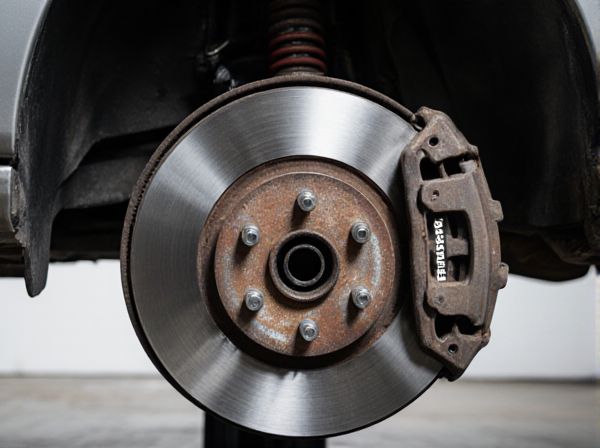
Photo illustration: Drum Brake vs Disc Brake
Disc brakes provide superior stopping power and heat dissipation compared to drum brakes, making them more effective for high-performance or heavy-duty vehicles. Drum brakes are typically more cost-effective and offer better protection from debris, which can be advantageous for rear wheel applications. Your choice between drum and disc brakes should consider factors like driving conditions, vehicle type, and maintenance preferences.
Table of Comparison
| Feature | Drum Brake | Disc Brake |
|---|---|---|
| Design | Enclosed drum housing brake shoes | Exposed rotating disc with caliper and pads |
| Performance | Lower stopping power, prone to fade | Higher stopping power, resists brake fade |
| Heat Dissipation | Poor, heat trapped inside drum | Excellent, air-cooled disc surface |
| Maintenance | Complex, harder to service | Simple, easier to inspect and replace pads |
| Cost | Lower initial cost | Higher initial cost |
| Usage | Common in rear brakes of economy vehicles | Standard in front brakes and performance cars |
| Durability | Good lifespan but susceptible to wear | Longer lifespan with consistent performance |
Introduction to Drum Brakes and Disc Brakes
Drum brakes use brake shoes that press outward against a rotating drum to create friction and slow the vehicle, offering durability and cost-effectiveness in various applications. Disc brakes employ calipers to squeeze brake pads onto a spinning disc, providing superior heat dissipation and more consistent stopping power. Both systems are essential in automotive braking, with drum brakes commonly found in rear wheels and disc brakes favored for front-wheel braking due to better performance under heavy use.
How Drum Brakes Work
Drum brakes operate by pushing brake shoes outward against a rotating drum attached to the wheel, creating friction that slows the vehicle. This friction converts kinetic energy into heat, effectively reducing wheel speed. Typically, drum brakes are enclosed systems, which protect internal components but can lead to heat buildup during heavy braking.
How Disc Brakes Work
Disc brakes operate by pressing brake pads against a rotating metal disc, or rotor, attached to the wheel, creating friction that slows the vehicle. Hydraulic pressure from brake fluid squeezes the caliper pistons, forcing the pads to clamp onto the rotor surface efficiently. This mechanism ensures rapid heat dissipation and consistent stopping power, making disc brakes highly effective for modern vehicles.
Key Differences Between Drum and Disc Brakes
Drum brakes feature a drum that rotates with the wheel, pressing brake shoes outward to create friction, while disc brakes use calipers to squeeze brake pads against a spinning disc. Disc brakes generally offer better heat dissipation, leading to improved performance and reduced brake fade compared to drum brakes, which are more prone to overheating. Maintenance differs as drum brakes involve more complex internal components, whereas disc brakes are simpler to inspect and replace.
Performance Comparison: Drum vs Disc Brakes
Disc brakes offer superior stopping power and heat dissipation compared to drum brakes, resulting in more consistent performance under heavy braking conditions. Drum brakes tend to suffer from brake fade due to poor heat dissipation and often require more maintenance to retain effectiveness. Performance tests consistently show disc brakes provide better modulation and shorter stopping distances, making them ideal for high-speed and demanding driving environments.
Maintenance and Durability
Drum brakes generally require less frequent maintenance due to their enclosed design, which protects components from dirt and debris; however, they tend to wear out faster under heavy use because of heat build-up affecting the brake shoe material. Disc brakes offer superior durability as their open design allows better cooling and consistent performance, reducing the risk of brake fade and extending lifespan, but they demand more regular inspection and servicing to maintain optimal function. Choosing between drum and disc brakes depends on balancing lower maintenance needs with the benefits of enhanced durability and performance in varying driving conditions.
Cost Analysis: Drum vs Disc Brakes
Drum brakes generally cost less to manufacture and maintain compared to disc brakes, making them a budget-friendly option for economy vehicles. Disc brakes, while more expensive upfront, offer longer lifespan and improved performance, which can reduce overall maintenance costs in the long term. The cost-efficiency balance depends on factors like driving conditions, vehicle type, and frequency of brake replacement.
Applications in Modern Vehicles
Drum brakes are commonly used in rear-wheel applications of economy cars and light trucks due to their cost-effectiveness and durability under low-speed conditions. Disc brakes dominate front-wheel braking systems in modern vehicles, providing superior heat dissipation, consistent stopping power, and enhanced performance during high-speed and aggressive driving. Advanced braking systems in performance and electric vehicles increasingly integrate disc brakes with anti-lock braking systems (ABS) and electronic stability control (ESC) for optimized safety and control.
Advantages and Disadvantages of Each Brake Type
Drum brakes offer superior braking force at lower costs and provide better performance in parking applications but suffer from poor heat dissipation leading to brake fade under heavy use. Disc brakes excel in heat dissipation and consistent stopping power, improving safety and performance in wet conditions, yet tend to be more expensive and complex to maintain than drum brakes. The choice between drum and disc brakes depends on factors like vehicle type, driving conditions, budget, and desired maintenance level.
Choosing the Right Brake System for Your Vehicle
Choosing the right brake system for your vehicle depends on factors such as vehicle type, driving conditions, and maintenance preferences. Drum brakes offer better performance in parking and low-speed applications, while disc brakes provide superior heat dissipation and stopping power under high-speed or heavy-load conditions. Evaluating your driving habits and vehicle requirements ensures optimal safety, efficiency, and longevity in brake system performance.
 caratoz.com
caratoz.com